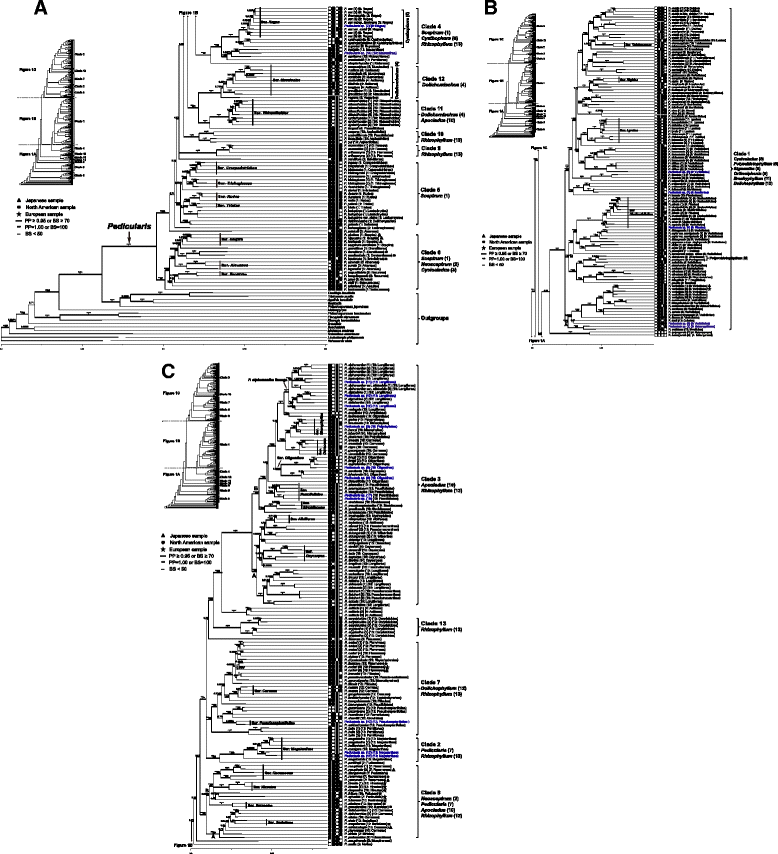Towards a comprehensive phylogeny of the large temperate genus Pedicularis (Orobanchaceae), with an emphasis on species from the Himalaya-Hengduan Mountains
- PMID: 26159907
- PMCID: PMC4498522
- DOI: 10.1186/s12870-015-0547-9
Towards a comprehensive phylogeny of the large temperate genus Pedicularis (Orobanchaceae), with an emphasis on species from the Himalaya-Hengduan Mountains
Abstract
Background: Striking interspecific variations in floral traits of the large temperate genus Pedicularis have given rise to controversies concerning infra-generic classifications. To date, phylogenetic relationships within the genus have not been well resolved. The main goal of this study is to construct a backbone phylogeny of Pedicularis, with extensive sampling of species from the Himalaya-Hengduan Mountains. Phylogenetic analyses included 257 species, representing all 13 informal groups and 104 out of 130 series in the classification system of Tsoong, using sequences of the nuclear ribosomal internal transcribed spacer (nrITS) and three plastid regions (matK, rbcL and trnL-F). Bayesian inference and maximum likelihood methods were applied in separate and combined analyses of these datasets.
Results: Thirteen major clades are resolved with strong support, although the backbone of the tree is poorly resolved. There is little consensus between the phylogenetic tree and Tsoong's classification of Pedicularis. Only two of the 13 groups (15.4 %), and 19 of the 56 series (33.9 %) with more than one sampled species were found to be strictly monophyletic. Most opposite-/whorled-leaved species fall into a single clade, i.e. clade 1, while alternate leaves species occur in the remaining 12 clades. Excluding the widespread P. verticillata in clade 1, species from Europe and North America fall into clades 6-8.
Conclusions: Our results suggest that combinations of morphological and geographic characters associated with strongly supported clades are needed to elucidate a comprehensive global phylogeny of Pedicularis. Alternate leaves are inferred to be plesiomorphic in Pedicularis, with multiple transitions to opposite/whorled phyllotaxy. Alternate-leaved species show high diversity in plant habit and floral forms. In the Himalaya-Hengduan Mountains, geographical barriers may have facilitated diversification of species with long corolla tubes, and the reproductive advantages of beakless galeas in opposite-/whorled-leaved species may boost speciation at high altitude.
Figures


References
-
- Fischer E. Scrophulariaceae. In: Kadereit JW, editor. The Families and genera of vascular plants. Berlin: Springer; 2004. pp. 333–432.
-
- Li H-L. A revision of the genus Pedicularis in China. part I. Proc Acad Natl Sci Phila. 1948;100:205–378.
-
- Olmstead RG. A synoptical classification of the Lamiales (version 2.4). 2012. http://depts.washington.edu/phylo/Classification.pdf.
-
- Wolfe A, Randle C, Liu L, Steiner K. Phylogeny and biogeography of Orobanchaceae. Folia Geobotanica. 2005;40(2):115–34. doi: 10.1007/BF02803229. - DOI
-
- Wu Z-Y, Lu A-M, Tang Y-C, Chen Z-D, Li D-Z. The families and genera of angiosperms in China: a comprehensive analysis. Beijing: Science Press; 2003.
Publication types
MeSH terms
Substances
LinkOut - more resources
Full Text Sources
Other Literature Sources
Miscellaneous

